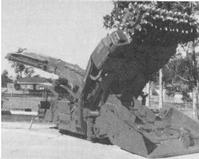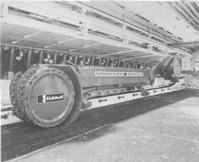


Chapter 11
I The Present Energy Economy
II Australian Energy Consumption
III Research And Development
IV Coal
i Transition at the coal face
ii Further development of face mechanisation
iii Mechanisation outside the face area
iv Open-cut mining in NSW
v Open-cut mining in Queensland
vi Underground mining in Queensland
vii The state of the art
viii Conclusion
V Oil And Natural Gas
VI Solar Energy
VII Nuclear Energy
VIII Bagasse Firewood And Other Biomass
IX Electric Power Generation And Distribution electric Power Generation And Distribution
X Manufactured Gas
XI Industrial Process Heat
Sources
Index
Search
Help
Contact us

Mechanisation outside the face area
Successful mechanisation is a total concept, for there are difficulties in grafting high production equipment to old mines with primitive coal haulage and transport systems. A mine designed a decade ago would now require to have its conveyor system up-dated to service a highly productive longwall operation, so that whatever form mechanisation exhibits at the face, and this is the prime consideration, everything else must be integrated to it.Mechanisation in itself has suffered a change since the first applications which were broadly based on coal cutters and separate loaders discharging into mine cars, these latter running on rails and when marshalled the tractive effort was generally supplied by electric locomotives, battery or trolley wire, or diesel locomotives. In this situation all mine servicing was carried out by rail cars.

The Second World War coincided with the onset of trackless mining, using rubber mounted shuttlecars, so that development of this system was arrested until hostilities ceased. With the appearance of the continuous miner a little later the concept gained impetus which was further reinforced by the use of conveyor belt haulage, a much better transport medium than rail haulage in the conditions usually met underground. Thus until the successful establishment of longwall operations around 1980 the systems in use were basically trackless, consisting of continuous miners, shuttlecars, conveyor haulage to the surface or to skip hoisting loading bins. The percentage of coal won by continuous miners in June 1984 was 82.9 per cent as only continuous miners and longwall were employed on face production.
Mine supply
Servicing such as man transport, timber supply and stone dust, etc., was gradually moving to the trackless era with a whole new range of equipment, most of it diesel powered, designed to carry out the lifting, stacking and transport functions involved both on the surface and underground.
Coal transport
At the present time, all coal is moved underground by belts which are classified as flame proof. For some time now the use of this type has been a regulation of the Statutory Authority concerned in each State. The use of the steel cored belting for long distances and high lifts, as in access tunnels, is commonplace, and for everyday use underground the capacity and reliability of the belt systems has kept pace with the increasing tonnages required to be hauled.
Strata support by roof bolting
The roof support system that has made possible the immense progress in mechanisation would not have been possible without the development of effective roof bolting techniques, and the success of mechanisation as exemplified by continuous miners, shuttlecars and latterly longwall units has tended to obscure the part that roof bolting has played in elevating these systems to the status they now enjoy. Experiments in the bolting of a mine roof were begun at Eirington Colliery on the South Maitland Field early in 1949, following the appearance of an article in the American publication Coal Mine Modernisation Year Book 1948. The immediate success of the system at Eirington indicated that it might also be a success in the support of weak roof strata immediately overlying the workable section of the Victoria Tunnel Seam at John Darling Colliery, Horseman (1951), and since those days it has become the main method of roof support in coal mines.

 |
Australian Academy of Technological Sciences and Engineering |  |
© 1988 Print Edition pages 791 - 792, Online Edition 2000
Published by Australian Science and Technology Heritage Centre, using the Web Academic Resource Publisher
http://www.austehc.unimelb.edu.au/tia/762.html